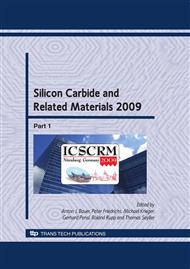p.411
p.415
p.419
p.423
p.427
p.431
p.435
p.439
p.443
Shallow Defects Observed in As-Grown and Electron-Irradiated or He+-Implanted Al-Doped 4H-SiC Epilayers
Abstract:
Aluminum-doped 4H-SiC samples were either irradiated with high-energy electrons (170 keV or 1 MeV) or implanted with a box-shaped He+-profile. Admittance spectroscopy (AS) and deep level transient spectroscopy (DLTS) were employed to search for defect centers. AS spectra of as-grown as well as of electron-irradiated (170 keV or 1 MeV) 4H-SiC epilayers reveal the Al acceptor (ΔE(Al) = 200 meV) and an unknown defect (ΔE(SB) = 177 meV), while AS spectra of the He+-implanted and annealed sample show in addition to the Al-acceptor two energetically deeper acceptor-like defect centers (ΔE(RE3) = 255 meV and ΔE(KR3) = 375 meV). The KR3-center is not directly formed by the He+-implantation, it requires an annealing process. The DLTS spectra of the He+-implanted and annealed sample resolve a double-peak structure of the KR3-defect (ΔE(KR3A) = 380 meV and ΔE(KR3B) = 410 meV).
Info:
Periodical:
Pages:
427-430
Citation:
Online since:
April 2010
Price:
Сopyright:
© 2010 Trans Tech Publications Ltd. All Rights Reserved
Share:
Citation:


